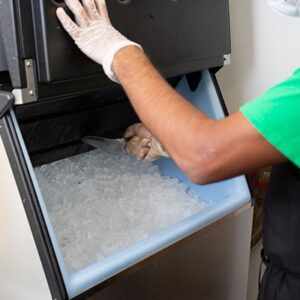
Keep your commercial ice maker in great shape with these handy tips!
Ice makers bring a lot of conveniences to commercial kitchens. It’s nice to have plenty of ice instantaneously at the touch of a button. However, as with any appliance, it takes the proper maintenance to prevent malfunctions and extend an ice maker’s lifespan. Adequate and consistent care also matters for hygienic purposes. We’re here to share some ice maker preventative maintenance tips.
Preventative Tips
Here are seven quick tips that can assist you in effectively taking care of your ice maker.
- Clean and sanitize your water system
- For air-cooled models, clean air filters
- Check the external filter system and change cartridges when necessary
- Inspect inlet water valve screens
- For extruded ice makers, conduct a bearing and auger inspection.
- Perform a visual inspection of controls, components, and wires for oil spots, loose fasteners, and corrosion
- Wash the bin interior and unit exterior
What to Know About Ice Maker Scale Buildup
Separation happens when ice forms on an ice machine evaporator plate. Minerals separate from the water and form lime, calcium, or iron scale that sticks to the water system components’ surfaces. This lime, calcium, or iron scale is even more visible when the surfaces are dry.
The color of the lime or calcium scale varies due to the minerals in the local water supply. For example, the lime or calcium scale will be off-white, while the iron scale will be rusty red. Algae or slime growth can also appear in some locations because air or water-born bacteria settle and grow in wet areas.
This scale buildup insulates the freezing surface on a cuber evaporator plate and impedes heat transfer. If the buildup remains, the ice cubes will stick to the plate and not harvest correctly. When the next cycle continues, excessive ice will freeze on the evaporator plate, resulting in a freeze-up. The scale sticks to the inside of the barrel, causing low production and poor ice quality on auger-driven Flaker or cubelet machines.
Cleaning and Sanitizing Scale
You must remove the scale by circulating a mild phosphoric acid solution throughout the ice maker’s water system. You always want to use the correct type and mixing solution as a cleaner. The cleaning instructions that you need are usually included in the instruction manual provided with the unit.
Once you clean the unit, it requires sanitization. For example, units with plated evaporators need a nickel-safe cleaner because it has a weaker acidic solution to protect the plating surface. Use a commercial ice machine sanitizer or a 5% sodium hypochlorite solution. Household bleach is an example of this.
Sanitization is critical to remove algae or slime because the sanitizer will eliminate current bacteria while preventing further growth. We suggest you not exceed the recommended mixing solution and thoroughly rinse the unit after sanitization.
Next, you want to clean and sanitize the storage bin at the same time while thoroughly flushing the water system and bin before allowing the unit bin to run again.
Cleaning the Condenser or Air Filter
The condenser fan blades require cleaning. If the condenser coil has dirt, grease, or grime buildup, use a non-corrosive cleaner and rinse with water thoroughly. As the cleaning solution does its job, you’ll want to clean the condenser or air filters if included on the unit while checking the inlet valve screen for restriction.
You might need a fin comb or brush for the coil fins on remote condenser units where the coil has exposure to outside elements. You must disconnect the condenser coil connections and circulate a cleaning solution through them for water-cooled condenser units.
Once you finish this, you must clean and readjust the water-regulating valve for proper flow while servicing or changing the filter cartridge on the external water filter/treatment system.
Performing a Visual Inspection and Cleaning the Exterior
Another part of ice maker preventative maintenance is inspecting the control box and electrical components for loose or burnt connections. Examine the refrigeration system and service access valves for oil spots or other leaks. A visual inspection can help you pinpoint future problems.
As your unit ages, you’ll also want to prepare a visual inspection of the auger and bearing surfaces. Assembly fasteners need tightening and a periodic check to ensure they aren’t loosening under pressure.
Finally, it would be best to use a soft cloth and a neutral cleaner (one that ranges between a pH of 6-8) to wipe down the stainless unit and storage bine exterior.
We hope that you’ve found these ice maker preventative maintenance tips helpful. Contact us today to learn more about preventative maintenance contracts.
CONTACT PINE HEIGHTS COMMERCIAL KITCHEN SERVICE, INC.!
Since 1971, Pine Heights Commercial Kitchen Service, Inc., has been the leader in Commercial Kitchen Equipment Services in the greater Baltimore Metropolitan area. We specialize in Restaurant Equipment Repair Services, Commercial Refrigeration, Preventive Maintenance, in-shop repairs, and over-the-counter parts.
At Pine Heights, our motto is simple: “Quality Service for Less.” We provide the highest level of commercial maintenance for a competitive rate. We are veteran and family-owned and operated and located in Baltimore at 2900 West Patapsco Ave., Baltimore, MD 21230.
If you are ready for reliable Commercial Kitchen Equipment Services in Maryland, contact us today by phone, fax, or at our Baltimore location! Also, keep in touch with us on Facebook and Twitter!
